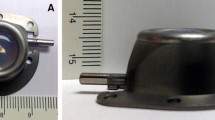Abstract
Conventional surgical technique of subcutaneous venous port placement describes dissection of the port pocket to the pectoralis fascia and suture fixation of the port to the fascia to prevent inversion of the device within the pocket. This investigation addresses the necessity of that step. Between October 8, 2004 and October 19, 2007, 558 subcutaneous chest ports were placed at our institution; 24 cases were excluded from this study. We performed a retrospective review of the remaining 534 ports, which were placed using standard surgical technique with the exception that none were sutured into the pocket. Mean duration of port use, total number of port days, indications for removal, and complications were recorded and compared with the literature. Mean duration of port use was 341 days (182,235 total port days, range 1–1279). One port inversion/flip occurred, which resulted in malfunction and necessitated port revision (0.2%). Other complications necessitating port removal included infection 26 (5%), thrombosis n = 2 (<1%), catheter fracture/pinch n = 1 (<1%), pain n = 2 (<1%), and skin erosion n = 3 (1%). There were two arrhythmias at the time of placement; neither required port removal. The overall complication rate was 7%. The 0.2% incidence of port inversion we report is concordant with that previously published, although many previous reports do not specify if suture fixation of the port was performed. Suture fixation of the port, in our experience, is not routinely necessary and may negatively impact port removal.


Similar content being viewed by others
References
Bjarnason H, Lehmann S (1988) Central venous access. In: Castaneda-Zuniga W, Tadavarthy S, Qian Z et al (eds) Interventional radiology. Williams and Wilkins, Baltimore, p 953
Wool NL (1991) Vascular access procedures. In: Economou SG, Witt TR, Deziel DJ et al (eds) Adjuncts to cancer surgery. Lea & Febiger, Philadelphia, pp 51–53
Raaf JH, Heil D, Rollins DL (1994) Vascular access pumps and infusions. In: McKenna RJ, Murphy GP (eds) Cancer surgery. Lippincott Williams & Wilkins, Philadelphia, pp 51–53
Gebarski SS, Gebarski KS (1984) Chemotherapy port “Twiddler’s syndrome”. A need for preinjection radiography. Cancer 54:38–39
de Costa BR, Dickey K, Greenwood L (2000) A practical approach for repositioning flipped venous access ports. J Vasc Interv Radiol 11:213–214
Kock HJ, Pietsch M, Krause U et al (1998) Implantable vascular access systems: experience in 1500 patients with totally implanted central venous port systems. World J Surg 22:12–16
Shetty P, Mody M, Kastan D et al (1997) Outcome of 350 implanted chest ports placed by interventional radiologists. J Vasc Interv Radiol 8:991
Sánchez LY, Galbis Caravajal JM, Fuster Diana CA et al (2006) Protocol for the implantation of a venous access device (Port-A-Cath system). The complications and solutions found in 560 cases. Clin Translation Oncol 8:735–741
Forauer AR, Chen Y, Parks R (2005) A case of posttraumatic Twiddler’s syndrome. J Vasc Interv Radiol 16:562–563
Charvát J, Linke Z, Horáèková M, Prausová J (2006) Implantation of central venous ports with catheter insertion via the right internal jugular vein in oncology patients—single center experience. Support Care Cancer 14:1162–1165
Hartkamp A, van Boxtel AJ, Zonnenberg BA et al (2000) Totally implantable venous access devices: evaluation of complications and a prospective comparative study of two different port systems. Neth J Med 57:215–223
Harvey WH, Pick TE, Reed K et al (1989) A prospective evaluation of the Port-A-Cath implantable venous access system in chronically ill adults and children. Surg Gynecol Obstet 169:495–500
Cil BE, Canyiğit M, Peynircioğlu B et al (2006) Subcutaneous venous port implantation in adult patients: a single center experience. Diagn Interv Radiol 12:93–98
Lorch H, Zwaan M, Kagel C et al (2001) Central venous access ports placed by interventional radiologists: experience with 125 consecutive patients. Cardiovasc Intervent Radiol 24:180–184
Author information
Authors and Affiliations
Corresponding author
Rights and permissions
About this article
Cite this article
McNulty, N.J., Perrich, K.D., Silas, A.M. et al. Implantable Subcutaneous Venous Access Devices: Is Port Fixation Necessary? A Review of 534 Cases. Cardiovasc Intervent Radiol 33, 751–755 (2010). https://doi.org/10.1007/s00270-009-9758-5
Received:
Accepted:
Published:
Issue Date:
DOI: https://doi.org/10.1007/s00270-009-9758-5




